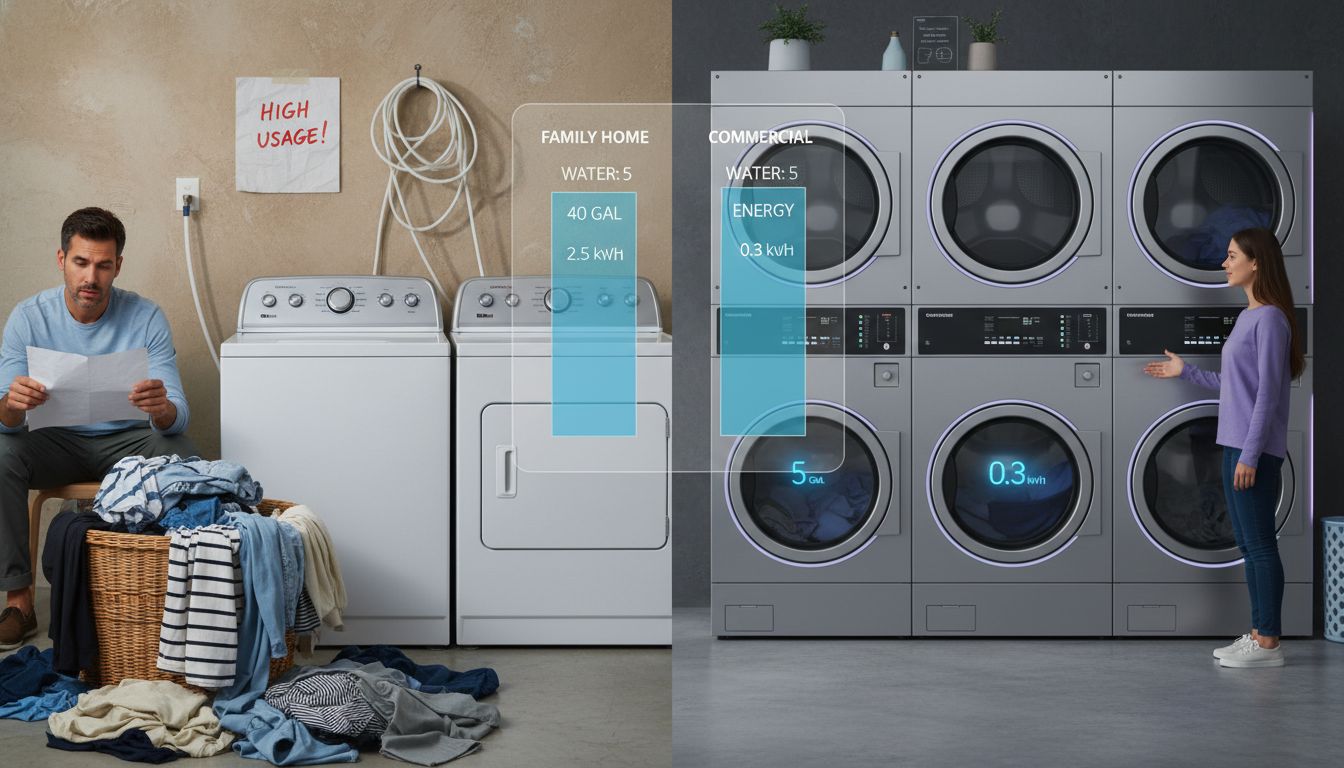Environmental Impact of Laundry: Complete Guide
- Sarah Huber
- Nov 8
- 6 min read

Every load of laundry uses up to 41 gallons of water, a figure that surprises many households. While washing and drying clothes feels routine, each cycle adds up, quietly shaping our water and energy bills and leaving a bigger mark on the environment than most people expect. Understanding the true environmental impact behind laundry can help you make smarter choices, cut waste, and protect both your home and the world around you.
Table of Contents
Key Takeaways
Point | Details |
Environmental Impact of Laundry | Laundry contributes significantly to water consumption, energy use, and chemical pollution, necessitating more sustainable practices. |
Efficient Appliances | Using modern high-efficiency washing machines can reduce water usage by 35-50% and energy consumption by approximately 50%. |
Chemical Awareness | Selecting eco-friendly and hypoallergenic detergents minimizes health risks and environmental harm from harmful chemicals. |
Commercial Laundry Advantages | Commercial laundry services use substantially less water and energy compared to traditional home methods, enhancing resource efficiency. |
Defining Environmental Impact of Laundry
Laundry might seem like a routine household task, but its environmental consequences are far more significant than most people realize. According to the National Park Service, laundry activities create substantial ecological challenges through massive water consumption, energy expenditure, and chemical emissions.
The environmental impact of laundry can be broken down into several key dimensions:
Water Usage: An average residential washing machine consumes approximately 41 gallons of water per single load. This translates to thousands of gallons annually for a typical household.
Energy Consumption: Clothes dryers account for nearly 6% of a home’s total energy use, contributing meaningfully to household carbon footprints.
Chemical Pollution: Many laundry products release volatile organic compounds (VOCs), with some chemicals even classified as potential carcinogens by the EPA.
As the Natural Resources Defense Council highlights, the scale of laundry’s environmental impact is substantial. The average family completes around 300 laundry loads per year, with washing machines consuming up to 20% of indoor water resources. These numbers underscore the critical need for more sustainable laundry practices.
Understanding these environmental dimensions is the first step toward making more responsible choices. By recognizing the hidden ecological cost of our laundry routines, we can begin implementing strategies that reduce water waste, minimize energy consumption, and limit chemical pollution. Learn more about sustainable approaches in our guide on eco-friendly laundry services.
Water and Energy Use in Laundry Processes
Laundry processes consume significant water and energy resources, making them a critical environmental consideration for households and businesses. According to research in the Integrated Environmental Assessment and Management journal, water heating alone accounts for 80-85% of total energy consumption in conventional top-loading washing machines.
The breakdown of energy and water consumption reveals some startling insights:
Water Heating: The majority of energy used in laundry processes goes toward heating water, making temperature selection a crucial environmental decision.
Machine Efficiency: Modern high-efficiency washers represent a significant improvement in resource management.
Cumulative Impact: Multiple loads per week can dramatically increase overall household water and energy consumption.
Research from Fashion and Textiles provides encouraging data about technological improvements. High-efficiency washers demonstrate remarkable resource conservation, using 35-50% less water and approximately 50% less energy per load compared to conventional machines.

This technological advancement offers a practical pathway for reducing environmental impact.
Understanding these resource dynamics empowers consumers to make more environmentally conscious choices. Simple strategies like using cold water, selecting high-efficiency machines, and consolidating laundry loads can significantly reduce water and energy consumption. For deeper insights into sustainable laundry practices, explore our guide on building a sustainable laundry service model.
Chemical Use and Pollutant Release Risks
Laundry chemicals pose significant environmental and health risks that often go unnoticed by consumers. According to Colorado State University’s Design and Merchandising department, common laundry products contain harmful substances that can damage ecosystems and human health.
The primary chemical concerns in laundry processes include:
Phosphates: Detergent additives that stimulate toxic algae growth in water systems
Volatile Organic Compounds (VOCs): Chemicals that can cause respiratory and skin issues
Synthetic Fragrances: Potential allergens that may trigger skin irritations and health complications
The National Park Service highlights a particularly alarming finding: many scented liquid detergents and dryer sheets emit volatile organic compounds, with some chemicals classified as potential carcinogens by the Environmental Protection Agency. These substances not only impact personal health but also contribute to broader environmental pollution.
Reducing chemical exposure requires thoughtful product selection and laundering practices. Consumers can minimize risks by choosing hypoallergenic, phosphate-free detergents, avoiding excessive fragrances, and opting for eco-friendly laundry solutions. For comprehensive insights into sustainable laundry practices, check out our guide on building a sustainable laundry service model.
Comparing Traditional vs. Commercial Laundry Services
The landscape of laundry services has dramatically evolved, with commercial laundry operations offering significant environmental advantages over traditional home laundering methods. According to research from Florida Atlantic University, the shift towards commercial laundry services can yield substantial resource efficiency improvements.
Key differences between traditional and commercial laundry services include:
Water Consumption: Energy Star® commercial washers use 18-25 gallons per load, compared to 40 gallons in standard home machines
Energy Efficiency: Commercial machines are designed for higher performance and lower resource consumption
Technological Optimization: Advanced commercial systems can significantly reduce environmental impact
Springer’s Euro-Mediterranean Journal highlights the ongoing research into optimizing industrial washing processes. Their dynamic modeling analysis suggests that commercial laundry operations have considerable potential to reduce energy consumption and wastewater discharge through strategic program and machine unit adjustments.
Ultimately, the environmental benefits of commercial laundry services extend beyond mere resource efficiency. By consolidating washing processes, using advanced technologies, and implementing sophisticated waste management strategies, commercial services can dramatically reduce the ecological footprint of laundry operations.

For a deeper understanding of these differences, explore our guide to residential versus commercial laundry services.
Sustainable and Eco-Friendly Laundry Practices
Making environmentally conscious choices in laundry practices can significantly reduce our ecological footprint. According to Colorado State University’s Design and Merchandising department, simple modifications to our laundry routine can dramatically minimize environmental impact.
Key sustainable laundry strategies include:
Cold Water Washing: Reduces carbon footprint by approximately 10%
Air Drying: Decreases climate impact by up to 67%
Reduced Washing Frequency: Conserves resources and extends garment life
Efficient Load Management: Maximizes water and energy usage
The National Park Service recommends additional eco-friendly approaches such as using Energy Star® certified appliances and avoiding scented detergents that contain hazardous chemicals. These practices not only benefit the environment but also contribute to healthier living spaces.
Implementing sustainable laundry practices requires a holistic approach. By consciously selecting energy-efficient appliances, using environmentally friendly detergents, and adopting resource-conservative washing techniques, individuals can make a meaningful difference. For comprehensive insights into reducing your laundry’s environmental impact, explore our guide on understanding the hidden environmental costs of laundry services.
Make Your Laundry Routine Part of the Environmental Solution
The article highlights how water consumption, energy use, and harmful chemicals in traditional laundry deeply impact our environment and health. If you want to lower your ecological footprint without sacrificing convenience, GoGet My Laundry offers a smart and responsible alternative. By using advanced commercial extractor washers that consume less water and energy while reducing drying times, we help you reduce environmental waste and garment wear.
Enjoy benefits like:
Cold water washing options for energy savings
Hypoallergenic and eco-friendly detergent choices
Flexible schedules with same-day pickup to fit your busy life
Options to hang dry or custom garment care to extend clothing life

Ready to take action for a greener lifestyle without hassle Take the step today at GoGet My Laundry. Learn how our eco-friendly laundry services support sustainable living and discover personalized solutions to fit your needs by visiting our guide on building a sustainable laundry service model and exploring residential service options. Make your laundry choices a force for good now.
Frequently Asked Questions
What is the environmental impact of laundry?
Laundry has significant environmental implications, including high water usage, considerable energy consumption for washing and drying, and chemical pollution from detergents that may release volatile organic compounds and other harmful substances.
How can I reduce water and energy usage during laundry?
To reduce water and energy usage, consider using cold water for washing, investing in high-efficiency washers, consolidating laundry loads, and air drying clothes whenever possible to minimize energy consumption.
What are the harmful chemicals often found in laundry products?
Common harmful chemicals in laundry products include phosphates, volatile organic compounds (VOCs), and synthetic fragrances, which can contribute to respiratory issues, skin irritations, and environmental damage through toxic algae growth in water systems.
How does commercial laundry differ from traditional home laundering in terms of environmental impact?
Commercial laundry services typically use advanced, energy-efficient machines that require less water per load, significantly reduce energy consumption, and employ optimized washing processes to minimize environmental impact compared to traditional home laundry methods.
Recommended

Comments